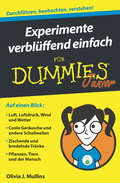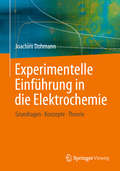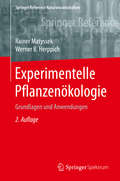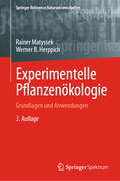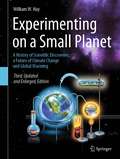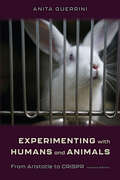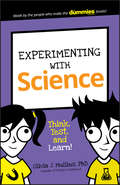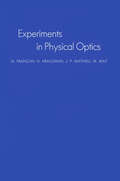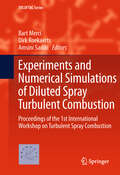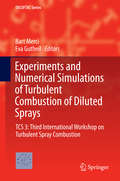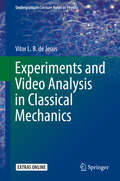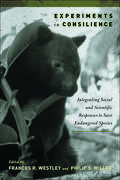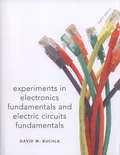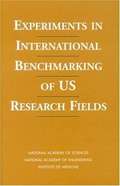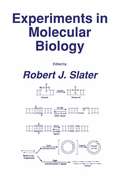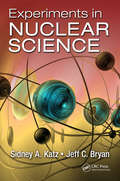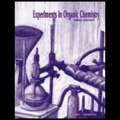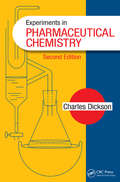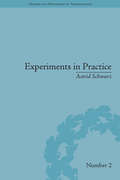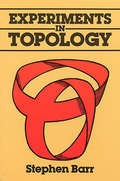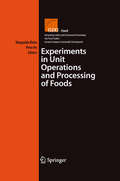- Table View
- List View
Experimente verblüffend einfach für Dummies Junior (Für Dummies)
by Olivia J. MullinsNaturwissenschaftler machen Experimente, um die Welt besser zu verstehen. Das kannst du auch! Folge den Anleitungen, schau genau und verstehe, was da passiert und was das mit dir zu tun hat. Verbiege einen Wasserstrahl. Finde heraus, wie sich die Luft bewegt. Mache aus einem Ei einen Gummiball. Teste deine Sinne und erfahre, wie das Gehirn arbeitet. Alles was du dazu brauchst, findest du im Haushalt oder kannst du im Supermarkt kaufen. Bestens geeignet für Kinder und Jugendliche ab 8 Jahre.
Experimentelle Einführung in die Elektrochemie: Grundlagen - Konzepte - Theorie
by Joachim DohmannDas vorliegende Buch vermittelt wichtige Grundlagen der Elektrochemie. Hierzu zählen - die Entstehung von Ladungsträgern- die Mechanismen des Ladungstransports- die Grundlagen der Elektrolyse- Elektrochemische Untersuchungsmethoden- Elektrochemische Spannungsquellen- industrielle AnwendungenDie Zusammenhänge werden anhand zahlreicher einführender Experimente erläutert. Neben einer kurzen Einführung in die jeweiligen theoretischen Vorstellungen werden experimentelle Aufbauten beschrieben, Ergebnisse mitgeteilt und interpretiert. Besondere Kenntnisse in den Fächern Chemie, Physik oder Elektronik werden nicht vorausgesetzt.Die ZielgruppenDas Buch wendet sich an Studierende der Fachrichtungen Maschinenbau, Verfahrenstechnik, Versorgungstechnik, Energietechnik und Umwelttechnik an Fachhochschulen und Universitäten. Zudem wendet es sich an Ingenieure dieser Bereiche, die Grundkenntnisse der Elektrochemie erwerben möchten. Das Buch wendet sich ferner an Studierende des Lehramts im Fach Chemie sowie an Chemielehrer der Sekundarstufe II.
Experimentelle Pflanzenökologie: Grundlagen und Anwendungen (Springer Reference Naturwissenschaften)
by Rainer Matyssek Werner B. HerppichAllen, die mit Planung, Durchführung und Auswertung von pflanzenökologischen Experimenten zu tun haben, bietet dieses Handbuch eine zuverlässige Basis. Die Autoren beschreiben die biophysikalischen, physikalisch-chemischen und physiologischen Grundlagen der experimentellen Pflanzenökologie sowie die Interaktionen zwischen Pflanzen und abiotischen Faktoren. Schwerpunktmäßig konzentrieren sie sich dabei auf Teilbereiche, die für den Freilandeinsatz von hoher Bedeutung sind. So behandeln sie insbesondere Fragen des Kohlenstoff- und des Wasserhaushaltes. Dabei werden einzelne Aspekte gezielt tiefgehend behandelt, auf ein oberflächliches Ansprechen möglichst vieler Teilbereiche dagegen verzichtet. Mineralstoffhaushalt und Bodenökologie wurden als Themen bewusst ausgeklammert, da für diese zum Teil andere wissenschaftliche und methodische Anforderungen gelten. Die Darstellung und Erläuterung von Messtechniken und Arbeitsmethoden der modernen experimentellen Pflanzenökologie runden das Buch ab.
Experimentelle Pflanzenökologie: Grundlagen und Anwendungen (Springer Reference Naturwissenschaften)
by Rainer Matyssek Werner B. HerppichAllen, die mit Planung, Durchführung und Auswertung von pflanzenökologischen Experimenten zu tun haben, bietet dieses Handbuch eine zuverlässige Basis. Die Autoren beschreiben die biophysikalischen, physikalisch-chemischen und ökophysiologischen Grundlagen der experimentellen Pflanzenökologie sowie die Interaktionen zwischen Pflanzen und abiotischen Faktoren. Schwerpunktmäßig konzentrieren sie sich dabei auf Teilbereiche, die für den Freilandeinsatz von hoher Bedeutung sind. So behandeln sie insbesondere Fragen des Kohlenstoff- und des Wasserhaushaltes. Dabei werden einzelne Aspekte gezielt vertiefend behandelt, auf ein oberflächliches Ansprechen möglichst vieler Teilbereiche dagegen verzichtet. Mineralstoffhaushalt und Bodenökologie wurden als Themen bewusst ausgeklammert, da für diese zum Teil andere wissenschaftliche und methodische Anforderungen gelten. Die Darstellung und Erläuterung von Messtechniken und Arbeitsmethoden der modernen experimentellen Pflanzenökologie, ergänzt durch eine Vielzahl von Forschungsbeispielen, bilden den Schwerpunkt dieses Buches. Das Werk basiert auf zwei vorangegangenen Auflagen gleichen Titels „Experimentelle Pflanzenökologie, Grundlagen und Anwendungen“ von Dieter von Willert, Rainer Matyssek und Werner B. Herppich, Thieme 1995 (1. Auflage), sowie Rainer Matyssek und Werner B. Herppich, Springer Nature 2019 (2. Auflage). Diese vorliegende 3. Auflage wurde ein weiteres Mal stark überarbeitet und erweitert.
Experimenting on a Small Planet: A History of Scientific Discoveries, a Future of Climate Change and Global Warming
by William W. HayThis book is a thorough introduction to climate science and global change. The author is a geologist who has spent much of his life investigating the climate of Earth from a time when it was warm and dinosaurs roamed the land, to today's changing climate. Bill Hay takes you on a journey to understand how the climate system works. He explores how humans are unintentionally conducting a grand uncontrolled experiment which is leading to unanticipated changes. We follow the twisting path of seemingly unrelated discoveries in physics, chemistry, biology, geology, and even mathematics to learn how they led to our present knowledge of how our planet works. He explains why the weather is becoming increasingly chaotic as our planet warms at a rate far faster than at any time in its geologic past. He speculates on possible future outcomes, and suggests that nature itself may make some unexpected course corrections. Although the book is written for the layman with little knowledge of science or mathematics, it includes information from many diverse fields to provide even those actively working in the field of climatology with a broader view of this developing drama. Experimenting on a Small Planet is a must read for anyone having more than a casual interest in global warming and climate change - one of the most important and challenging issues of our time. This new edition includes actual data from climate science into 2021. Numerous Powerpoint slides can be downloaded to allow lecturers and teachers to more effectively use the book as a basis for climate change education.
Experimenting with Forces and Motion, Student Guide
by National Science Resources Center Taina Litwak Dane J. TolerNIMAC-sourced textbook
Experimenting with Humans and Animals: From Aristotle to CRISPR (Johns Hopkins Introductory Studies in the History of Science)
by Anita GuerriniExamining the ideas and attitudes that encourage scientists to experiment on living creatures, what their justifications are, and how these have changed over time.Experimentation on animals—particularly humans—is often assumed to be a uniquely modern phenomenon. But the ideas and attitudes that encourage biological and medical scientists to experiment on living creatures date from the earliest expressions of Western thought. In Experimenting with Humans and Animals, Anita Guerrini looks at the history of these practices and examines the philosophical and ethical arguments that justified them.Guerrini discusses key historical episodes in the use of living beings in science and medicine, including the discovery of blood circulation, the development of smallpox and polio vaccines, and recent research in genetics, ecology, and animal behavior. She also explores the rise of the antivivisection movement in Victorian England, the modern animal rights movement, and current debates over gene therapy and genetically engineered animals. We learn how perceptions and understandings of human and animal pain have changed; how ideas of class, race, and gender have defined the human research subject; and that the ethical values of science seldom stray far from the society in which scientists live and work.Thoroughly rewritten and updated, with new material in every chapter, the book emphasizes a broader understanding of experimentation and adds material on gene therapy, self-experimentation, and prisoners and slaves as experimental subjects. A new chapter brings the story up to the present while reflecting on the current regulatory scene, new developments in science, and emerging genomics. Experimenting with Humans and Animals offers readers a context within which to understand more fully the responsibility we all bear for the suffering inflicted on other living beings in the name of scientific knowledge.
Experimenting with Humans and Animals: From Galen to Animal Rights (Johns Hopkins Introductory Studies In The History Ser.)
by Anita GuerriniExperimentation on animals and particularly humans is often assumed to be a uniquely modern phenomenon. But the ideas and attitudes that encourage the biological and medical sciences to experiment on living creatures date from the earliest expression of Western thought. <p><p> In Animal and Human Experimentation, the author looks at the history of these practices from vivisection in ancient Alexandria to present-day battles over animal rights and medical research employing human subjects. The author discusses in-depth key historical episodes in the use of living beings in science and medicine, including the discovery of blood circulation, the development of smallpox and polio vaccines, and recent AIDS research. <p><p> She also explores the rise of the antivivisection movement in Victorian England, the modern animal rights movement, and current debates over gene therapy. In this highly accessible text, we learn how our understanding of an animal's capacity to feel pain has evolved. The author reminds us that the ethical values of science seldom stray far from those of the society in which scientists live and work. Ethical questions about the use of animals and humans in research remain among the most vexing within both the scientific community and society at large. These often rancorous arguments have gone on, however, with little awareness of their historical antecedents. <p><p> Animal and Human Experimentation offers students and concerned general readers on every side of this debate a context within which to understand more fully the responsibility we all bear for the suffering inflicted on other living beings in the name of scientific knowledge.
Experimenting with Mixtures, Compounds, and Elements, Student Guide
by National Science Resources Center Kitty Lou Smith Susie DuckworthNIMAC-sourced textbook
Experimenting with Science: Think, Test, and Learn!
by Olivia J. MullinsThere's no better way to learn about the world around you than to test how things work. The experiments in this book help you understand how to test the laws of science while learning more about how the world works. The invisible force of air--test how air moves and how it affects nature Mix up some potions--use household chemicals to create unexpected results How does the brain work?--challenge your perceptions with experiments that test your senses This book is part of the 'Dummies Junior' initiative, a new series extension from the trusted For Dummies brand that is created to appeal to and educate younger readers. The series applies the core For Dummies approach of presenting complicated topics in a light-hearted and non-intimidating way while adding key changes for the unique needs of this audience, including: A design that is heavy on eye-poppign graphics and focused on the steps to completing a project A small, full-color, non-intimidating package that instills confidence in the reader A focus on 2-3 basic projects that sets the student on the road to further exploration
Experiments In Ecology
by A. J. UnderwoodEcological theories and hypotheses are usually complex because of natural variability in space and time, which often makes the design of experiments difficult. The statistical tests we use require data to be collected carefully and with proper regard to the needs of these tests. This book, first published in 1996, describes how to design ecological experiments from a statistical basis using analysis of variance, so that we can draw reliable conclusions. The logical procedures that lead to a need for experiments are described, followed by an introduction to simple statistical tests. This leads to a detailed account of analysis of variance, looking at procedures, assumptions and problems. One-factor analysis is extended to nested (hierarchical) designs and factorial analysis. Finally, some regression methods for examining relationships between variables are covered. Examples of ecological experiments are used throughout to illustrate the procedures and examine problems. This book will be invaluable to practising ecologists as well as advanced students involved in experimental design.
Experiments In Physical Optics
by M. Francon N. Krauzman J.P. Mathieu M. MayExperiments in physical optics for undergraduate and graduate classes. Provides the theoretical basis of each experiment and describes the apparatus required and necessary adjustments. Most of the experiments require only lenses, prisms, mirrors, and polarizers, and can be projected on a lecture screen or viewed by television.
Experiments and Numerical Simulations of Diluted Spray Turbulent Combustion
by Bart Merci Dirk Roekaerts Amsini SadikiThis book reflects the outcome of the 1st International Workshop on Turbulent Spray Combustion held in 2009 in Corsica (France). The focus is on reporting the progress of experimental and numerical techniques in two-phase flows, with emphasis on spray combustion. The motivation for studies in this area is that knowledge of the dominant phenomena and their interactions in such flow systems is essential for the development of predictive models and their use in combustor and gas turbine design. This necessitates the development of accurate experimental methods and numerical modelling techniques. The workshop aimed at providing an opportunity for experts and young researchers to present the state-of-the-art, discuss new developments or techniques and exchange ideas in the areas of experimentations, modelling and simulation of reactive multiphase flows. The first two papers reflect the contents of the invited lectures, given by experts in the field of turbulent spray combustion. The first concerns computational issues, while the second deals with experiments. These lectures initiated very interesting and interactive discussions among the researchers, further pursued in contributed poster presentations. Contributions 3 and 4 focus on some aspects of the impact of the interaction between fuel evaporation and combustion on spray combustion in the context of gas turbines, while the final article deals with the interaction between evaporation and turbulence.
Experiments and Numerical Simulations of Turbulent Combustion of Diluted Sprays
by Bart Merci Eva GutheilThis book reflects the results of the 2nd and 3rd International Workshops on Turbulent Spray Combustion. The focus is on progress in experiments and numerical simulations for two-phase flows, with emphasis on spray combustion. Knowledge of the dominant phenomena and their interactions allows development of predictive models and their use in combustor and gas turbine design. Experts and young researchers present the state-of-the-art results, report on the latest developments and exchange ideas in the areas of experiments, modelling and simulation of reactive multiphase flows. The first chapter reflects on flame structure, auto-ignition and atomization with reference to well-characterized burners, to be implemented by modellers with relative ease. The second chapter presents an overview of first simulation results on target test cases, developed at the occasion of the 1st International Workshop on Turbulent Spray Combustion. In the third chapter, evaporation rate modelling aspects are covered, while the fourth chapter deals with evaporation effects in the context of flamelet models. In chapter five, LES simulation results are discussed for variable fuel and mass loading. The final chapter discusses PDF modelling of turbulent spray combustion. In short, the contributions in this book are highly valuable for the research community in this field, providing in-depth insight into some of the many aspects of dilute turbulent spray combustion.
Experiments and Video Analysis in Classical Mechanics (Undergraduate Lecture Notes in Physics)
by Vitor L. B. de JesusThis book is an experimental physics textbook on classical mechanics focusing on the development of experimental skills by means of discussion of different aspects of the experimental setup and the assessment of common issues such as accuracy and graphical representation. The most important topics of an experimental physics course on mechanics are covered and the main concepts are explored in detail. Each chapter didactically connects the experiment and the theoretical models available to explain it. Real data from the proposed experiments are presented and a clear discussion over the theoretical models is given. Special attention is also dedicated to the experimental uncertainty of measurements and graphical representation of the results. In many of the experiments, the application of video analysis is proposed and compared with traditional methods.
Experiments in Consilience: Integrating Social And Scientific Responses To Save Endangered Species
by Frances Westley Philip S. MillerIn his 1998 book Consilience, E.O. Wilson set forth the idea that integrating knowledge and insights from across the spectrum of human study -- the humanities, social science, and natural sciences -- is the key to solving complex environmental and social problems. Experiments in Consilience tells the unique story of a pathbreaking effort to apply this theoretical construct in a real-world setting. The book describes the work of the Biodiversity Research Network, a team of experts from the United States and Canada brought together to build interdisciplinary connections and stimulate an exchange of expertise. Team members sought to understand the ecology and population dynamics of key species in particular ecosystems, to understand the impact of human populations on those species and ecosystems, and to develop tools and processes for involving a greater variety of stakeholders in conservation efforts. In order to keep the experiment grounded, the network focused on a single type of conservation planning workshop run by a single organization -- the Population and Habitat Viability Assessment Workshop (PHVA) of the IUCN-sponsored Conservation Breeding Specialist Group (CBSG). The book combines sections on the theoretical underpinnings of relevant concepts in population biology, simulation modeling, and social science with detailed descriptions of six PHVA workshops conducted on different species across four continents. Through the combination of theory and application, combined with frank discussions of what the research network learned -- including both successes and failures -- the book offers fresh ideas on how to improve on-the-ground conservation decisionmaking. Experiments in Consilience offers a one-of-a-kind overview and introduction to the challenges of cross-disciplinary analysis as well as cross-functional, cross-disciplinary and cross-sectoral action.
Experiments in Electronics Fundamentals and Electric Circuits Fundamentals, Eighth Edition
by David M. BuchlaThis laboratory manual is designed to accompany Electronics Fundamentals. The manual is designed to help you measure and record data as efficiently as possible.
Experiments in International Benchmarking of US Research Fields
by Institute of Medicine National Academy of Engineering National Academy of ScienceInformation on the Experiments in International Benchmarking of US Research Fields
Experiments in Molecular Biology
by Robert J. SlaterResearch in the field of molecular biology has progressed at a fascinating rate in recent years. Much of this progress results from the development of new laboratory techniques that allow very precise fractionation and analysis of nucleic acids and proteins, as well as the construction of recombinant DNA molecules that can then be cloned and expressed in host cells. Progress has been so rapid that there has been a shortfall in the training of appropriately qualified staff. Many existing laboratory workers require retraining, and many educational institutions have had difficulty incorporating the new molecular biology techniques into their teaching programs. Although there are several manuals currently available that describe laboratory techniques in molecular biology, they are principally written for the individual research worker and are not intended for use in the design of practical classes for students. The aim of this book is to provide just such a series of protocols for the teaching of practical molecular biology. The idea arose following the success of several Workshops in Molecular Biology, organized and taught by staff in the Biology Department of the Hatfield Polytechnic. Gradually, the protocols used in the workshops have been incorporated into the Hatfield undergraduate and postgraduate teaching pro grams and have now been collected together to form a book.
Experiments in Nuclear Science
by Sidney A. Katz Jeff C. BryanExperiments in Nuclear Science is an introductory-level laboratory manual providing hands-on opportunities for developing insights into the origins and properties of nuclear radiations, their interactions with matter, their detection and measurement, and their applications in the physical and life sciences. Based on experiments successfully perform
Experiments in Organic Chemistry
by Richard Hill John BarbaroThis laboratory manual is intended for use in an introductory course in organic chemistry. The authors have used it both in the full-year course for chemistry majors and premedical students and in shorter sequences designed for students in the biological sciences, pharmacy, nursing, agriculture, and nutrition. A unique feature of this manual is the inclusion of a number of Mystery Reactions. These are experiments in which the outcome and nature of the reaction product are not given, posing a mystery for the student to solve. The organic chemistry laboratory provides a wonderful opportunity to practice the application of logical reasoning and deduction in the solution of structural problems.
Experiments in Pharmaceutical Chemistry
by Charles DicksonWritten by an author with more than 40 years of teaching experience in the field, Experiments in Pharmaceutical Chemistry, Second Edition responds to a critical classroom need for material on directed laboratory investigations in biological and pharmaceutical chemistry. This new edition supplies 75 experiments, expanding the range of topics to 22 m
Experiments in Practice (History and Philosophy of Technoscience #2)
by Astrid SchwarzTraditionally experimentation has been understood as an activity performed within the laboratory, but in the twenty-first century this view is being challenged. Schwarz uses ecological and environmental case studies to show how scientific experiments can transcend the laboratory.
Experiments in Topology
by Stephen Barr"A mathematician named KleinThought the Moebius band was divine.Said he: 'If you glueThe edges of two,You'll get a weird bottle like mine.' " -- Stephen BarrIn this lively book, the classic in its field, a master of recreational topology invites readers to venture into such tantalizing topological realms as continuity and connectedness via the Klein bottle and the Moebius strip. Beginning with a definition of topology and a discussion of Euler's theorem, Mr. Barr brings wit and clarity to these topics:New Surfaces (Orientability, Dimension, The Klein Bottle, etc.)The Shortest Moebius StripThe Conical Moebius StripThe Klein BottleThe Projective Plane (Symmetry)Map ColoringNetworks (Koenigsberg Bridges, Betti Numbers, Knots)The Trial of the Punctured TorusContinuity and Discreteness ("Next Number," Continuity, Neighborhoods, Limit Points)Sets (Valid or Merely True? Venn Diagrams, Open and Closed Sets, Transformations, Mapping, Homotopy)With this book and a square sheet of paper, the reader can make paper Klein bottles, step by step; then, by intersecting or cutting the bottle, make Moebius strips. Conical Moebius strips, projective planes, the principle of map coloring, the classic problem of the Koenigsberg bridges, and many more aspects of topology are carefully and concisely illuminated by the author's informal and entertaining approach.Now in this inexpensive paperback edition, Experiments in Topology belongs in the library of any math enthusiast with a taste for brainteasing adventures in the byways of mathematics.
Experiments in Unit Operations and Processing of Foods
by Maria Margarida Cortez Vieira Peter HoIn chemical engineering and related fields, a unit operation is a basic step in a process. For example in milk processing, homogenization, pasteurization, chilling, and packaging are each unit operations which are connected to create the overall process. A process may have many unit operations to obtain the desired product. The book will cover many different unit operations as they apply to food processing.
